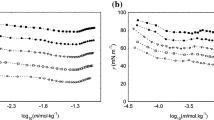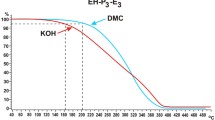Summary
Complexes of nonionic surfactantsR-(OCH2CH2)x OH with montmorillonite have been studied (R =n-hexadecyl,n-octadecyl and oleyl ;x=2, 10 and 20).
On internal surfaces the surfactant molecules are arranged in bilayers. Withx=2 the alkyl chain and about one half of the polar group, (-R OCH2CH2O-) stand perpendicularly whereas the terminal —CH2CH2OH group is attached to the silicate surface (β1-phase). The bilayer thickness decreases stepwise with rising temperature due to the formation of kinks (βi-phases). At higher temperature (52 °C withR=C18H37-, 43°C withR=n-C16H33-, and 12 °C withR = oleyl-) surfactant molecules are squeezed out of the interlayer space reversibly, the packing density decreases, the whole polar head group gets attached to the silicate surface and the alkyl chains rearrange into a gauche-block structure. This structure undergoes further structural changes at still higher temperatures (α i -phases).
The complexes withx =10 and 20 form α-phases even at room temperature. These α-phases take up long chain alkanol molecules under formation of β-structures which rearrange at higher temperatures into α-phases. Long-chain impurities of the surfactants can be intercalated in a similar way.
Previous data indicating mono- or bilayers of flatly lying surfactant molecules refer to metastable phases due to steric hindrances of lattice expansion.
It is proposed that the surfactant molecules build up similar films on the external surfaces, which can adopt β- or α-structures depending upon number of ethylene oxide groups and temperature. The films of hexadecyl polyglycol ethers for instance are about 27 Å thick in the β-phases and about 17 Å in the a-phases.
Zusammenfassung
Es wurden Montmorillonitkomplexe mit nichtionogenen TensidenR(-OCH2CH2) x ,OH (R =n-hexadecyl-,n-octadecyl- und oleyl-;x = 2, 10 and 20) hergestellt. Die Tensidmoleküle bilden zwischen den Silicatschichten bimolekulare Filme.
Mitx=2 sind die hydrophoben Reste und die anschließende -OCH2CH2-Äthergruppe bei niedriger Temperatur gestreckt und senkrecht zu den Silicatschichten orientiert (β i -Phase); nur die endständige HOCH2CH2-Gruppe sitzt direkt auf der Silicatschicht auf. Beim Erwärmen erniedrigt sich die Dicke der bimolekularen Tensidschicht stufenweise durch den Einbau von Kinken (β i -Phasen). Bei höheren Temperaturen (52°C mitR =C18H37-, 43 °C mitR =C16H33- und 12 °C mitR = oleyl) werden Tensidmoleküle reversibel aus den Schichtzwischenräumen verdrängt, die Packungsdichte erniedrigt sich, die gesamte polare Gruppe kommt in direkten Kontakt mit der Silicatschicht und die Alkylketten ordnen sich in eine Gaucheblockstruktur (α i -Phase). Diese kann bei noch höheren Temperaturen weitere Phasenumwandlungen erleiden.
Mitx =10 undx = 20 werden auch bei Zimmertemperatur nur α-Phasen gebildet. Diese α-Phasen können zusätzlich langkettige Alkanolmoleküle aufnehmen und ternäre Komplexe mit β-Struktur bilden, die sich beim Erhitzen reversibel in α-Formen umwandeln. Langkettige polare Verunreinigungen in den Tensiden wirken ähnlich wie die Alkanolmoleküle.
An den äußeren Oberflächen werden die Tensidmoleküle gleichartige Filme mit β- oder α-Struktur bilden, je nach der Zahl der -CH2CH2O-Gruppen und der Temperatur. Ein Film aus Hexadecylpolyglykoläthern wird etwa 27 Å dick sein in der β-Phase und etwa 17 Å in der α-Form.
Similar content being viewed by others
Literatur
Jordan, W., J. Phys. Coll. Chem.53, 294 (1949); Mineral. Mag.28, 598 (1949).
Erbring, H., H. Lehmann, Kolloid Z.107, 201 (1944).
Cowan, D. T., D. White, Trans. Farad. Soc.54, 691 (1958).
Weiss, A., Chem. Ber.91, 487 (1958) ; Clays Clay Minerals 10, 191 (1963); Angew. Chem.75, 113 (1963).
McAtee, J. L., Amer. Mineral.44, 1230 (1959).
Brindley, G. W., R. W. Hoffmann, Proc. 9th Nat. Clay Conf., p. 546 (New York 1962).
Greenland, D. J., J. P. wirk, Proc. 9th Nat. Clay Conf., p. 484 (New York 1962); J. Phys. Chem.67, 2886 (1963).
Serratosa, J. M., W. D. Johns, A. Sbimoyama, Clays Clay Min.18, 107 (1970);J. A. Martin Rubi, J. A. Rausell-Colom, J. M. Serratosa, Clays Clay Min.22, 87 (1974).
Hower, W. F., Clays and Clay Minerals18, 97 (1970).
Lagaly, G., A. Weiss, Kolloid Z. Z. Polymere237, 266 (1970);237, 364 (1970);238, 485 (1970);243, 48 (1971).
Lagaly, G., H. Stange, M. Teramasso, A. Weiss, Israel J. Chem.8, 399 (1970).
Lagaly, G., A. Weiss, Kolloid Z. Z. Polymere248, 968 (1971);248, 979 (1971); Angew. Chem.83, 580 (1971).
Rupprecht, H., M. Biedermann, Colloid & Polymer Sci.252, 558 (1974);H. Rupprecht, Acta Pharmaceut. Technol.22, 37 (1976).
Lagaly, G., H. Stange, A. Weiss, Proc. Int. Clay Conf. 1972, p. 693 (Madrid 1973).
Flegmann, A. W., Proc. Int. Clay Conf. Stockholm 1963, Vol. I, p. 333 (London-New York 1965).
Kukolev, G. V., I. I. Nemets, G. D. Smchenko, Zh. Prikl. spektrosk.17, 454 (1972).
Wayman, C. H., Proc. Int. Clay Conf. Stockholm 1963, Vol. I, p. 329 (London-New York 1965).
Law, J. P., G. W. Kunze, Soil Sci. Soc. Amer. Proc.30, 321 (1966).
Gummukuru, S. R., K. Marti, V. V. Volk, M. L. Jackson, Soil Sci. Soc. Amer. Proc.30, 685 (1966).
Schott, H., Kolloid Z. Z. Polymere219, 42 (1967).
Schott, H., Kolloid Z. Z. Polymere199, 158 (1964).
Forster, W. R., J. M. Waite, Symposium on Chemistry in the Exploration and Production of Petroleum, A.C.S.-Division of Petroleum Chem., 39 (Dallas, Texas 1956).
Desmyanova, E. A., Primen. Poverkl. Aktiv. Veshchesto Neft. Prom. Tr. Vses. Soveshch. 3rd USSR, 168 (1965).
Schott, H., J. Colloid. Interf. Sci.26, 133 (1968).
Barclay, L. M., R. H. Ottewill, Disc. Farad. Soc.1, 138 (1970).
Smith, G. H., US-Patent 3 384 174 (1968).
Brindley, G. W., S. Ray, Am. Mineral.49, 106 (1964).
Pfirrmann, G., G. Lagaly, A. Weiss, Clays and Clay Minerals21, 239 (1973).
Lagaly, G., S. Fitz, A. Weiss, Clays and Clay Minerals23, 45 (1975).
Weiss, A., J. Spiess, E. Stuke, G. Lagaly, Z. Naturforsch.27b, 317 (1972).
Lagaly, G., E. Stuke, A. Weiss, Progr. Colloid & Polymer Sci. (1976).
Bradley, W. F., E. J. Weiss, R. A. Rowland, Clays and Clay Min. Proc. Nat. Conf.10, 117 (1963).
Reynolds, R. C., Jr., Amer. Mineral.50, 990 (1965).
Parfitt, R. L., D. J. Greenland, Clay Min.8, 305 (1970).
MacEwan, D. C. M., Trans. Farad. Soc.44, 349 (1948); Nature154, 577 (1944);W. F. Bradley, J. Am. Chem. Soc.67, 975 (1945).
Hoffmann, R. W., G. W. Brindley, Amer. Mineral.46, 450 (1961).
Dowdy, R. H., M. M. Mortland, Clays Clay Min.15, 259 (1966).
Carter, D. L., M. D. Heilmann, C. L. Gonzalez, Soil Sci.100, 356 (1965).
Brindley, G. W., Am. Mineral.41, 91 (1956).
lappman, W. D., Johns, N. Jb. Miner. Mh., 212 (1969);Cp. F. Venial, H. W. van der Marel, Proc. Internat. Clay Conf. Tokyo 1969, Vol. II, p. 78 (Jerusalem 1970).
Reynolds, C. R., Jr., Amer. Mineral.54, 562 (1969).
Ottewill, R. H., Walker, Kolloid Z. Z. Polymere227, 108 (1968); cp.P. Bagchi, J. Colloid. Interf. Sci.50, 115 (1975).
Author information
Authors and Affiliations
Rights and permissions
About this article
Cite this article
Platikanov, D., Weiss, A. & Lagaly, G. Orientation of nonionic surfactants on solid surfaces: n-alkyl polyglycol ethers on montmorillonite. Colloid & Polymer Sci 255, 907–915 (1977). https://doi.org/10.1007/BF01617099
Received:
Issue Date:
DOI: https://doi.org/10.1007/BF01617099




